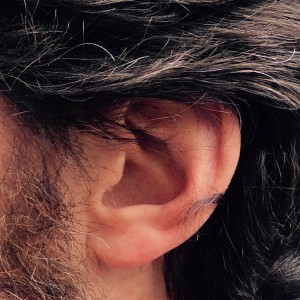I believe that every human being needs to listen consciously in order to live fully — connected in space and in time to the physical world around us, connected in understanding to each other, not to mention spiritually connected, because every spiritual path I know of has listening and contemplation at its heart.
–Julian Treasure
For the past few days I’ve had the luxury of time, and I’ve spent an hour of that time every day consciously listening. My sense of hearing has been noticeably active the entire time I’ve been awake, but for an hour every day I’ve been deliberately focusing on sounds and proliferating the meaning that I make from those sounds, to the exclusion of all other mental and physical activity.
Call it ‘meditating on sounds’ if you wish, but it is quite a different practice to the more usual method of meditating on the breath. Martine Batchelor highlights the key point in her book ‘Meditation for life’:
Concentrating only on the breath or the body, you can sometimes become too locked inside yourself. Listening to sounds is a wonderful meditation that opens you to the world around.
So, with that in mind, in this blog post I will describe what this formal meditation practice involves, why it might be something that you should engage with, and how the experience went for me this morning when I practiced it.
Sitting and listening
The conditions for the practice are straightforward enough: find a safe location where you won’t be disturbed, and plan to remain there, eyes closed, for a specific period of time. For the first quarter of that time you consciously listen to sounds within your body, internal sounds. For the second quarter you consciously listen to sounds coming from immediately around you. For the next quarter you consciously listen to sounds coming from further afield, and for the final quarter you just listen to whatever presents itself to your awareness. Forget about the fourth stage if you prefer.
 Usual mediation instructions apply… Get prepared: stick with one posture that you’re comfortable with (standing, sitting, lying – not walking, as you’ve got your eyes shut!), eliminate preventable distractions (turn the phone off, make sure someone else can attend to the kids, do not drive or operate heavy machinery) and if you’re anxious about strictly marking time then use an audible timer of some kind (such as the Insight timer app).
Usual mediation instructions apply… Get prepared: stick with one posture that you’re comfortable with (standing, sitting, lying – not walking, as you’ve got your eyes shut!), eliminate preventable distractions (turn the phone off, make sure someone else can attend to the kids, do not drive or operate heavy machinery) and if you’re anxious about strictly marking time then use an audible timer of some kind (such as the Insight timer app).
During the meditation: keep your eyes closed and your body still, remember that your intention is to listen to sounds, and if you notice that your mind has wandered away from the object of your meditation then recall your intention and get back to the object without giving yourself a hard time.
Afterwards: spend a few moments in quiet contemplation, to allow yourself to digest the experience of conscious listening, have a good think if you want, and don’t forget to open your eyes again before you move on to whatever’s next.
Why consciously listen?
The best reasons that I can give for engaging in this practice are explained beautifully by the ‘sound consultant’ Julian Treasure in his TED talk called ‘5 ways to listen better’. In brief, then, he reminds us that the act of listening (of making meaning from sounds that we hear) is a mental process that employs techniques like pattern recognition, differencing and a host of other filters. These aren’t really categorised as cognitive biases, but they do invisibly shape our perception of our surroundings and, as such, we can arguably make better decisions if we’re better aware of the processes that are shaping our worldview.
Julian Treasure’s argument is that in an increasingly noisy world we are losing the ability to listen consciously, and that this is not a trivial problem as listening is our access to understanding our situation in the world and our relationships with others. Treasure goes on to describe five simple exercises that you can do to improve your conscious listening, and the meditation on sounds that I’m advocating here includes most of the useful aspects of all five. I highly recommend watching the full talk, it’s under eight minutes long.
Towards the end of the talk he admits to not knowing how to get this practice more widely adopted, but that we need to find a way. Perhaps it is something that could be taught in schools? I’m a teacher, and I’ve often shared Julian Treasure’s talks with my Sixth Form tutor group because he’s such an engaging speaker with an important message to get across – but perhaps I could be doing more to help the students engage with the practice of conscious listening, at the very least to appreciate what quiet might mean in our increasingly noisy world.
So, I’m suggesting that if this integrative practice appeals to you then try it out. If you’ve done it before, try it again. If it doesn’t appeal to you, try it anyway… it doesn’t have to be complicated or take up a lot of your time, it’s the sort of thing you can do in queue at the supermarket. Notice that the awareness that you develop in this practice can be brought into conscious listening during conversations, in your interactions with others. Then, if you feel like you’re benefiting from this practice, please share it with someone else. Make a difference in your own web of connections, as that’s all you can realistically do!
Appendix – Journal notes from this morning’s meditation
Read on only if you’re interested in my own personal experience of the meditation on sounds from this morning. I sat on a cushion on the decking in the garden outside my back door, and set the Insight Timer app on my iPad to make a pinging sound once every fifteen minutes for a total of one hour. When I finished I moved back indoors and sat at the laptop to type up my recollections from the meditation, which are pasted in below…
Part 1 of 4 – Attention on internal sounds
The familiar ‘ringing’ in my ears. High pitched, continuous. Unchanging pitch. Higher pitch than any of the external sounds coming in. Unchanging volume. Does it come more from one side or the other? Neither, it seems to be in the middle. Same place as the internal monologue. Interminable. And always in my head, between my ears – never in any other part of my body.
Mind wanders, drifts away with thoughts. When I realise that I’m not focusing on the internal ringing sound I notice that I was not aware of it. Trying to use this effect to make it ‘go away’, to deliberately mask the ringing by thinking thoughts, doesn’t have that effect. The ringing is still there in the background, behind the internal voice of my thoughts. Why don’t I perceive my internal ‘vocal’ thoughts to be a sound, whereas the ringing is perceived as a sound?
 Part 2 – Attention on nearby sounds
Part 2 – Attention on nearby sounds
Ping. Nearby on my left, the bell sound from the iPad, telling me that 15 minutes is up. Nearby sounds… the birds in the garden are the most obvious. Most prominent is the robin. It is nearby, higher up, slightly to one side. Never the same phrase twice, but always a sweet melody. Phrase, then a pause of about the same length, then another phrase and so on.
Later I notice, sometimes, that there is another robin singing in the pauses, further away and on my other side. There are fainter sounds from blue tits, reedier and not melodious. I can name the birds from their songs, should I be naming them or listening to them? It seems automatic, to name them from the sounds. Feeling a sense of achievement in this ability. The pigeons, not vocalising but noisily flapping their wings in the newly leaved branches of the tree above. Probably visiting their nest that they’ve built high up in the tree. Occasional flapping and fluttering, the robin sings on.
Laughter from my son in the house behind me, long unselfconscious giggling – he is probably still reading that Tom Gates book. What do I do that makes him laugh like that? Other domestic sounds from the house: the ironing board opening up, the electronic peep of the iron when it is switched on, again when it reaches working temperature. Some inaudible speech, a conversation.
Aware in the silences that I sometimes notice the internal ringing, wonder if I should be paying attention to the gaps between the birdsong phrases? That’s one of the big differences between these nearby sounds and the internal ringing. That and the directionality, and obviously the externality. The bird sounds sound like they are ‘out there’.
Ambulance goes up the street in front of the house, siren sounding. Should I classify the traffic noise as nearby or far? It’s probably the same distance away as some of the birds. Tyre noise is like a swooshing, I can tell if they’re going up the road or down the road. (Afterthought: I didn’t notice the clanking of the loose drain cover as the cars passed over it). Occasional toot of a horn from the crossroads down the road.
Interrupted by the song of a blackbird, from further away directly in front of me. I picture it sitting on the TV aerial of the flats beyond the end of the garden. It sounds different to the robin. I’m naming bird species again. The song is more reverberant, I imagine it being reflected from the wall along the alleyway.
Part 3 – Attention on far away sounds
Ping. Loud bell sound, slightly startling. Straight away – jet aircraft a long way overhead, background but loud. As it fades the two-tone parp-parp of a train from a mile or so away. Funny that these two far away sounds should be so obliging as to happen within 10 seconds of start of the ‘far away’ section of this meditation. The sound of the jet plane very slowly fades, merging into other nearer sounds.
Then struggling to notice any other ‘far away’ sounds over the road noise, a motorbike engine, cars braking as they approach the traffic lights. Again wonder if these are classified as near or far.
Another plane sound, high up but to the left. This one’s a prop plane, not a jet. Identifying and discriminating again. The local airport does do both jets and props. Thumping sounds from my son playing a jumping around in the lounge at the front of the house.
A boiler starts up – could be ours or the neighbours. It’s ours, someone’s probably having a shower – can hear the boiler, but not the showering sounds as the bathroom’s round the front of the house and I’m at the back. Notice that there are fewer bird sounds, perhaps the robin’s flown elsewhere and the pigeon has settled on its nest.
Part 4 – Wide open attention on any sounds
After this ping I notice another jet plane sound from directly overhead. Funny – the last one I heard was after the previous ping, are they every hour? No, it was fifteen minutes ago. The time’s going by so quickly, why did I think it was an hour ago?
My breathing has become very gentle and calm, not really making any noticeable sound as I breathe in and out through my nose. I’ve not been at all focused on my breath – not like when I’m running and its the major focus of my attention. Yet somehow I’ve managed to stay alive.
Hard to recollect much from this final section. Certainly felt a sense of space, of not being in my head whilst still getting engrossed in discursive thoughts. Time going by very quickly, slightly surprised by the final ping and immediately a feeling of ‘disappointment’ that I hadn’t been ‘doing it right’ for the past 15 minutes. What would I journal about? Dismissed it. The conscious intention was to just see what happened when I listened to anything for the final 15 minutes. And a kind of ambiguous aware but not aware state was what happened.
Follow this link to read my previous meditation blog post: Meditation 15: What if I’m doing it wrong?
Index of previous meditation blogs
Picture of listening man with cap on bench by Skitterphoto. License: CC0 Public Domain (courtesy of Pixabay.com)
Pictures of my left ear and the robin in my back garden are all my own work. License: CC0 Public Domain


